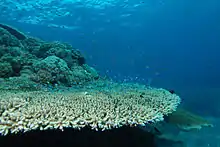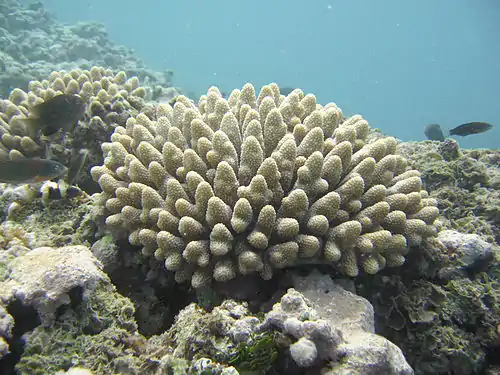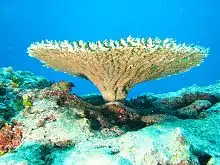Acropora
Acropora is a genus of small polyp stony coral in the phylum Cnidaria.[3] Some of its species are known as table coral, elkhorn coral, and staghorn coral. Over 149 species are described.[4] Acropora species are some of the major reef corals responsible for building the immense calcium carbonate substructure that supports the thin living skin of a reef.
| Acropora | |
|---|---|
 | |
| Acropora pulchra | |
| Scientific classification | |
| Kingdom: | Animalia |
| Phylum: | Cnidaria |
| Class: | Anthozoa |
| Order: | Scleractinia |
| Family: | Acroporidae |
| Genus: | Acropora Oken, 1815[2] |
| Species | |
|
See text | |
| Synonyms | |
|
List
| |
Anatomy and distribution
Depending on the species and location, Acropora species may grow as plates or slender or broad branches. Like other corals, Acropora corals are colonies of individual polyps, which are about 2 mm across and share tissue and a nerve net. The polyps can withdraw back into the coral in response to movement or disturbance by potential predators, but when undisturbed, they protrude slightly. The polyps typically extend further at night to help capture plankton and organic matter from the water.
Threats
Symbiodinium, symbiotic algae, live in the corals' cells and produce energy for the animals through photosynthesis. Environmental destruction has led to a dwindling of populations of Acropora, along with other coral species. Acropora is especially susceptible to bleaching when stressed. Bleaching is due to the loss of the coral's zooxanthellae, which are a golden-brown color. Bleached corals are stark white and may die if new Symbiodinium cells cannot be assimilated. Common causes of bleaching and coral death include pollution, abnormally warm water temperatures, increased ocean acidification, sedimentation, and eutrophication.
In 2014 the U.S. Fish and Wildlife Service has listed[5] 10 Acropora species as Threatened. The species are distributed in the Indo-Pacific (over 100 species) and Caribbean (3 species). However, the true number of species is unknown: firstly, the validity of many of these species is questioned as some have been shown to represent hybrids, for example Acropora prolifera;[6] and secondly, some species have been shown to represent cryptic species complexes.[7]
Reef-keeping

Most Acropora species are brown or green, but a few are brightly colored, and those rare corals are prized by aquarists. Captive propagation of Acropora is widespread in the reef-keeping community. Given the right conditions, many Acropora species grow quickly, and individual colonies can exceed a meter across in the wild. In a well-maintained reef aquarium, finger-sized fragments can grow into medicine ball-sized colonies in one to two years. Captive specimens are steadily undergoing changes due to selection which enable them to thrive in the home aquarium. In some cases, fragments of captive specimens are used to repopulate barren reefs in the wild.[8]
Acropora species are challenging to keep in a home aquarium. They require bright light, stable temperatures, regular addition of calcium and alkalinity supplements, and clean, turbulent water.
Common parasites of colonies in reef aquariums are "Acropora-eating flatworms" Amakusaplana acroporae,[9] and "red bugs" (Tegastes acroporanus).
Species

The following species are recognised in the genus Acropora:[10]
- Acropora abrolhosensis Veron, 1985
- Acropora abrotanoides (Lamarck, 1816)
- Acropora acervata (Dana, 1846)
- Acropora aculeus (Dana, 1846)
- Acropora acuminata (Verrill, 1864)
- Acropora alvarezi† Wallace, 2008
- Acropora anglica† (Duncan, 1866)
- Acropora anthocercis (Brook, 1893)
- Acropora arabensis Hodgson and Carpenter, 1995
- Acropora arafura Wallace, Done & Muir, 2012
- Acropora aspera (Dana, 1846)
- Acropora austera (Dana, 1846)
- Acropora awi Wallace and Wolstenholme, 1998
- Acropora bartonensis† Wallace, 2008
- Acropora batunai Wallace, 1997
- Acropora borneoensis† (Felix, 1921)
- Acropora branchi Riegl, 1995
- Acropora britannica† Wallace, 2008
- Acropora bushyensis Veron and Wallace, 1984
- Acropora capillaris (Klunzinger, 1879)
- Acropora cardenae Wells, 1986
- Acropora carduus (Dana, 1846)
- Acropora caroliniana Nemenzo, 1976
- Acropora cerealis (Dana, 1846)
- Acropora cervicornis (Lamarck, 1816) - staghorn coral
- Acropora chesterfieldensis Veron and Wallace, 1984
- Acropora clathrata (Brook, 1891)
- Acropora cytherea (Dana, 1846)
- Acropora darrellae† Santodomingo, Wallace & Johnson, 2015
- Acropora deformis† (Michelin, 1840)
- Acropora dendrum (Bassett-Smith, 1890)
- Acropora derawaensis Wallace, 1997
- Acropora desalwii Wallace, 1994
- Acropora digitifera (Dana, 1846)
- Acropora divaricata (Dana, 1846)
- Acropora donei Veron and Wallace, 1984
- Acropora downingi Wallace, 1999
- Acropora duncani† (Reuss, 1866)
- Acropora echinata (Dana, 1846)
- Acropora elegans (Milne-Edwards and Haime, 1860)
- Acropora elenae† Santodomingo, Wallace & Johnson, 2015
- Acropora elseyi (Brook, 1892)
- Acropora emanuelae† Santodomingo, Wallace & Johnson, 2015
- Acropora eurystoma (Klunzinger, 1879)
- Acropora fastigata Nemenzo, 1967
- Acropora fennemai† (Gerth, 1921)
- Acropora fenneri Veron, 2000
- Acropora filiformis Veron, 2000
- Acropora florida (Dana, 1846)
- Acropora gemmifera (Brook, 1892)
- Acropora glauca (Brook, 1893)
- Acropora globiceps (Dana, 1846)
- Acropora gomezi Veron, 2000
- Acropora grandis (Brook, 1892)
- Acropora granulosa (Milne-Edwards and Haime, 1860)
- Acropora haidingeri† (Reuss, 1864)
- Acropora halmaherae Wallace and Wolstenholme, 1998
- Acropora hasibuani† Santodomingo, Wallace & Johnson, 2015
- Acropora hemprichii (Ehrenberg, 1834)
- Acropora herklotsi† (Reuss, 1866)
- Acropora hoeksemai Wallace, 1997
- Acropora horrida (Dana, 1846)
- Acropora humilis (Dana, 1846)
- Acropora hyacinthus (Dana, 1846)
- Acropora indonesia Wallace, 1997
- Acropora intermedia (Brook, 1891)
- Acropora jacquelineae Wallace, 1994
- Acropora japonica Veron, 2000
- Acropora kimbeensis Wallace, 1999
- Acropora kirstyae Veron and Wallace, 1984
- Acropora kosurini Wallace, 1994
- Acropora lamarcki Veron, 2000
- Acropora latistella (Brook, 1892)
- Acropora laurae† Santodomingo, Wallace & Johnson, 2015
- Acropora lavandulina† (Michelin, 1840)
- Acropora listeri (Brook, 1893)
- Acropora loisetteae Wallace, 1994
- Acropora lokani Wallace, 1994
- Acropora longicyathus (Milne-Edwards and Haime, 1860)
- Acropora loripes (Brook, 1892)
- Acropora lovelli Veron and Wallace, 1984
- Acropora lutkeni Crossland, 1952
- Acropora macrocalyx† Wallace & Bosselini, 2015
- Acropora microclados (Ehrenberg, 1834)
- Acropora microphthalma (Verrill, 1869)
- Acropora millepora (Ehrenberg, 1834)
- Acropora monticulosa (Brueggemann, 1879)
- Acropora mossambica Riegl, 1995
- Acropora multiacuta Nemenzo, 1967
- Acropora muricata (Linnaeus, 1758)
- Acropora nana (Studer, 1878)
- Acropora nasuta (Dana, 1846)
- Acropora natalensis Riegl, 1995
- Acropora ornata† (DeFrance, 1828)
- Acropora palmata (Lamarck, 1816) - elkhorn coral
- Acropora palmerae Wells, 1954
- Acropora paniculata Verrill, 1902
- Acropora papillare Latypov, 1992
- Acropora pectinata Veron, 2000
- Acropora pharaonis (Milne-Edwards and Haime, 1860)
- Acropora pichoni Wallace, 1999
- Acropora piedmontensis† Wallace & Bosselini, 2015
- Acropora plumosa Wallace and Wolstenholme, 1998
- Acropora polystoma (Brook, 1891)
- Acropora prolifera (Lamarck, 1816) - fused staghorn coral
- Acropora proteacea† Wallace, 2008
- Acropora proximalis Veron, 2000
- Acropora pulchra (Brook, 1891)
- Acropora renemai† Santodomingo, Wallace & Johnson, 2015
- Acropora retusa (Dana, 1846)
- Acropora ridzwani Ditlev, 2003
- Acropora robusta (Dana, 1846)
- Acropora roemeri† (Duncan, 1866)
- Acropora rongelapensis Richards & Wallace, 2004
- Acropora roseni Wallace, 1999
- Acropora rudis (Rehberg, 1892)
- Acropora rufa Veron, 2000
- Acropora russelli Wallace, 1994
- Acropora salentina† Wallace & Bosselini, 2015
- Acropora samoensis (Brook, 1891)
- Acropora sarmentosa (Brook, 1892)
- Acropora secale (Studer, 1878)
- Acropora selago (Studer, 1878)
- Acropora seriata (Ehrenberg, 1834)
- Acropora serrata Lamarck
- Acropora simplex Wallace and Wolstenholme, 1998
- Acropora sirikitiae Wallace, Phongsuwan & Muir, 2012
- Acropora slovenica† Wallace & Bosselini, 2015
- Acropora solanderi† (Defrance, 1828)
- Acropora solitaryensis Veron and Wallace, 1984
- Acropora sordiensis Riegl, 1995
- Acropora spathulata (Brook, 1891)
- Acropora speciosa (Quelch, 1886)
- Acropora spicifera (Dana, 1846)
- Acropora squarrosa (Ehrenberg, 1834)
- Acropora striata (Verrill, 1866)
- Acropora subglabra (Brook, 1891)
- Acropora subulata (Dana, 1846)
- Acropora suharsonoi Wallace, 1994
- Acropora sukarnoi Wallace, 1997
- Acropora tanegashimensi -s Veron, 1990
- Acropora tenella (Brook, 1892)
- Acropora tenuis (Dana, 1846)
- Acropora torihalimeda Wallace, 1994
- Acropora tortuosa (Dana, 1846)
- Acropora tuberculosa (Milne Edwards, 1860)
- Acropora turaki Wallace, 1994
- Acropora valenciennesi (Milne-Edwards and Haime, 1860)
- Acropora valida (Dana, 1846)
- Acropora variolosa (Klunzinger, 1879)
- Acropora vaughani Wells, 1954
- Acropora verweyi Veron and Wallace, 1984
- Acropora walindii Wallace, 1999
- Acropora willisae Veron and Wallace, 1984
- Acropora wilsonae† Wallace, 2008
- Acropora yongei Veron and Wallace, 1984
References
- Wallace, C. C; Rosen, B. R (2006-04-22). "Diverse staghorn corals (Acropora) in high-latitude Eocene assemblages: implications for the evolution of modern diversity patterns of reef corals". Proceedings of the Royal Society B: Biological Sciences. 273 (1589): 975–982. doi:10.1098/rspb.2005.3307. ISSN 0962-8452. PMC 1560246. PMID 16627283.
- WoRMS (2010). "Acropora Oken, 1815". WoRMS. World Register of Marine Species. Retrieved 2012-02-10.
- "Acropora". Integrated Taxonomic Information System.
- Archived 2011-08-12 at the Wayback Machine Acropora at Encyclopedia of Life
- U.S. Fish and Wildlife Service. "Endangered and Threatened Wildlife and Plants; Adding 20 Coral Species to the List of Endangered and Threatened Wildlife" (PDF). Federal Register. 79 (219): 67356–67359.
- Vollmer, S.; Palumbi, S. (2002). "Hybridization and the Evolution of Reef Coral Diversity". Science. 296 (5575): 2023–2025. doi:10.1126/science.1069524. PMID 12065836.
- Ladner, Jason T.; Palumbi, Stephen R. (2012). "Extensive sympatry, cryptic diversity and introgression throughout the geographic distribution of two coral species complexes". Molecular Ecology. 21 (9): 2224–2238. doi:10.1111/j.1365-294X.2012.05528.x. PMID 22439812.
- "Restoration". The Global Coral Repository. 2011. Archived from the original on 2011-12-19. Retrieved 2011-12-08.
- Rawlinson, K. A.; Gillis, J. A.; Billings, R. E.; Borneman, E. H. (2011). "Taxonomy and life history of the Acropora-eating flatworm Amakusaplana acroporae nov. sp. (Polycladida: Prosthiostomidae)". Coral Reefs. 30 (3): 693–705. doi:10.1007/s00338-011-0745-3.
- "WoRMS - World Register of Marine Species - Acropora Oken, 1815". www.marinespecies.org. Retrieved 2018-05-28.
Further reading
- Reyes-Bermudez, Alejandro; Lin, Zhiyi; Hayward, David C.; Miller, David J.; Ball, Eldon E. (2009). "Differential expression of three galaxin-related genes during settlement and metamorphosis in the scleractinian coral Acropora millepora". BMC Evolutionary Biology. 9: 178. doi:10.1186/1471-2148-9-178. PMC 2726143. PMID 19638240.
- Shinzato, Chuya; Shoguchi, Eiichi; Kawashima, Takeshi; Hamada, Mayuko; Hisata, Kanako; Tanaka, Makiko; Fujie, Manabu; Fujiwara, Mayuki; Koyanagi, Ryo; Ikuta, Tetsuro; Fujiyama, Asao; Miller, David J.; Satoh, Nori (2011). "Using the Acropora digitifera genome to understand coral responses to environmental change". Nature. 476 (7360): 320–323. doi:10.1038/nature10249. PMID 21785439.
External links
| Wikispecies has information related to Acropora. |
| Wikimedia Commons has media related to Acropora. |
